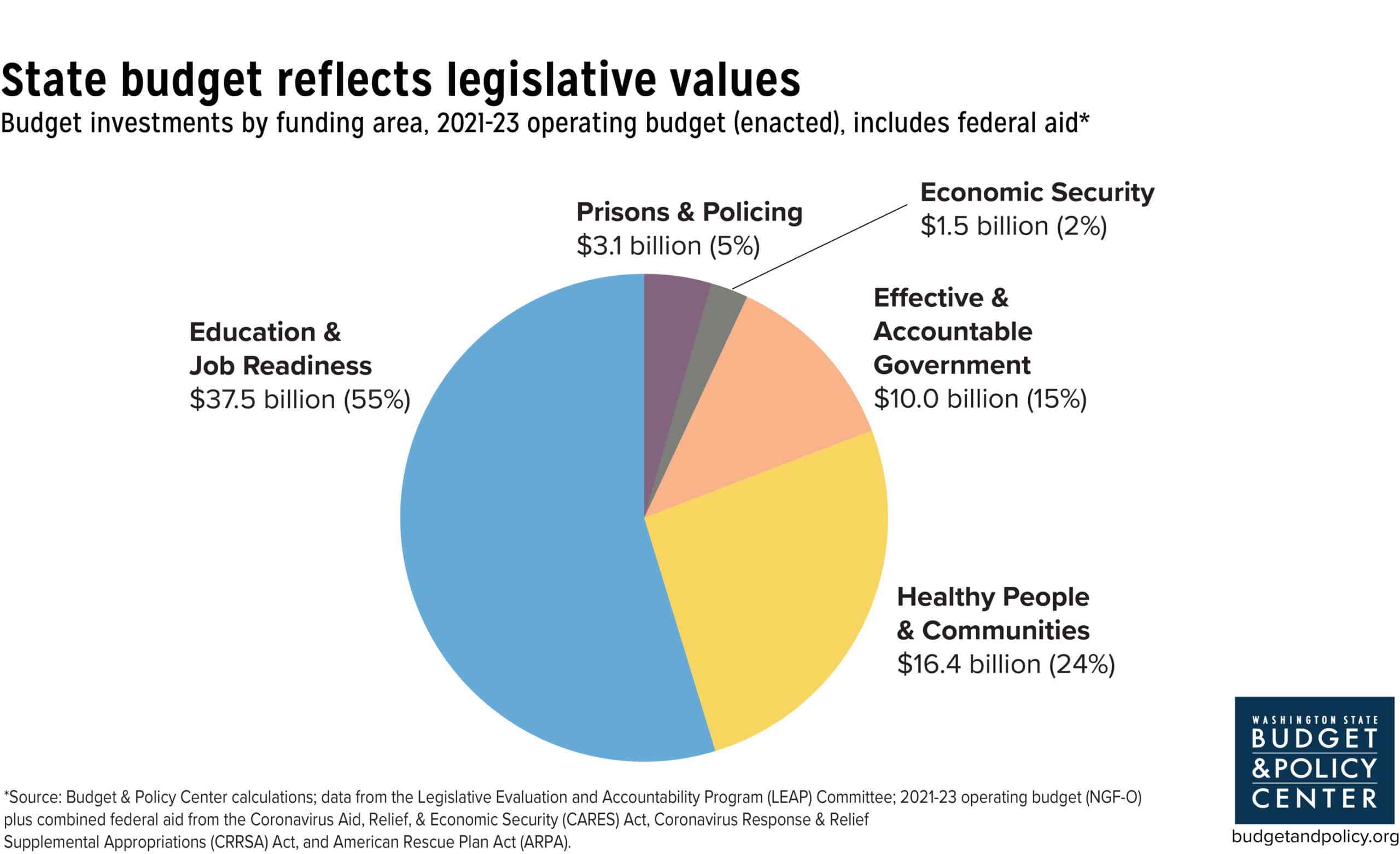At the heart of safety and security are essentials like a warm home and access to money, food, and healthcare. These basic needs lay a foundation for stability, dignity, and choice for people and those they care for.
But for generations, Black, Indigenous, and People of Color (BIPOC) communities have been subjected to systems that have limited their access to these essential needs in order to preserve wealth and opportunity primarily for white families. And rather than using local, state, and federal budgets to repair this historical and contemporary harm, policymakers have instead often invested in policing and prison systems that penalize and criminalize people for not having access to these essentials.
The good news is federal dollars from the American Rescue Plan (ARP) can help change this. With about $1 billion in remaining ARP funds,1 Washington state has an opportunity to change the way we approach public safety. A new report by the Center on Budget and Policy Priorities uplifts what communities — particularly communities of color — have been demanding for many years: shifting funds from policing to people-centered approaches to health, wellness, and safety.
With extreme economic inequities often at the root of offenses that are criminalized, many times traditional policing is not the most effective response when what may be needed is access to basic needs or services. And far too often, the actions of law enforcement officers have led to needless harm and even death, particularly of Black and brown people.
Policing disproportionately targets people of color, LGBTQ+ people, and people with disabilities
Washington’s total incarceration rate more than doubled from 1978 to 2016, and the state’s prison population nearly quadrupled in the same period.2 Current policing practices have led to disproportionate arrests, convictions, and incarceration of people of color. Although Black people represent 3% of the state population, they make up 19% of people sentenced to prison and 28% of people with a life sentence.2 And an appalling 47% of Black transgender people in the U.S. will face incarceration at least once in their lifetimes, a rate significantly higher than the general population.3
With extreme economic inequities often at the root of offenses that are criminalized, traditional policing is often not the most effective response when what may be needed is access to basic needs or services.
Police in schools have created what is known as the school-to-prison pipeline, where Black and brown students and students with disabilities disproportionately face suspension, expulsion, and school arrests. In the context of this increased police presence in schools, the percent of Black students who are suspended or expelled is more than twice as high as the percentage for all students.
The use of law enforcement for traffic control also leads to increased surveillance and encounters between police and people of color. Black, Indigenous, Asian, and Latinx drivers are cited more often for traffic violations and are charged with more serious offenses.
Policing and other criminal legal functions are costly to the state budget
Funding for prisons and policing costs our state $3.1 billion in the 2021-2023 biennium. This is more than twice the amount spent on programs that improve economic security, such as the Employment Security Department, Department of Labor and Industries, Department of Vocational Rehabilitation, and more. And since the start of the pandemic, Washington allocated $62.4 million from federal funds for pandemic relief toward the Department of Corrections.

However, these large expenditures on policing do not effectively improve public safety. Research shows that policing practices like mandatory sentencing, weapons enhancements, and longer sentences – all of which add burdensome costs to the state budget – do not reduce crime or improve public safety.2 Spending billions of dollars to uphold a system that does not achieve its core purpose and even targets and harms Black and brown, LGBTQ+, and people with disabilities is an imprudent use of taxpayer money.
Policymakers can use state dollars more effectively by investing in programs that bolster personal and community stability like housing, education, and health care.
American Rescue Plan funds can support alternatives to policing that communities are calling for
In Washington state, many community organizations – including Washington for Black Lives, Washington Black Lives Matter Alliance, and the Seattle Solidarity Budget — have called for shifting funding from policing to behavioral health services, substance use treatment, affordable housing, and other social and health services. Many of the services that advocates call for as policing alternatives would improve health, education, and job outcomes, creating a stronger state economy and healthier, more economically secure residents. Investments in policing alternatives can also play a role in reducing incarceration and monitoring of communities of color.
Many of the services that advocates call for as policing alternatives would improve health, education, and job outcomes, creating a stronger state economy and healthier, more economically secure residents.
Washington state can use ARP funds targeted for specific purposes, as well as flexible State and Local Fiscal Recovery Funds intended to help states and localities rebound from the pandemic, to strengthen programs and services that provide people with critical supports. These include:
- Mobile crisis mental health services. ARP encourages states to fund mobile mental health crisis intervention services through Medicaid. Many communities send police to respond to reports of individuals in mental health crisis, rather than responding with health care professionals. However, police are not mental health professionals and often have limited training to engage effectively with people with mental illnesses or to de-escalate situations. Sending mobile mental health crisis intervention services increases the likelihood that people in crisis are connected to the help they need and are diverted from arrest and jail.
- Better access to and quality of treatment and services for people with substance use disorders. Investing more in substance use services would help ensure people get needed treatment and limit the chances that substance use disorder results in arrest or incarceration.
- Alternatives to police in schools. Schools can use the additional funds to engage in trauma-informed education, hire social workers, school psychologists, and counselors, and invest in extracurricular activities.
- Shifting services currently provided by police to other public agencies. State and local governments can use these funds to address the public impacts of the pandemic, including a rise in violence, by supporting violence interruption services that work to address issues of stress in communities with a high rate of violence before they require police intervention. The Fiscal Recovery Funds also include a provision that allows states to spend some of this aid to replace revenue lost in the pandemic. State and local governments could use these funds to create new non-police units to manage traffic control, reducing the most common police interaction with the public and one that disproportionately targets people of color.
- Affordable housing. Ensuring that everyone acquires the basic need of housing will improve safety and security for all Washingtonians. Increasing access to decent affordable housing contributes to more stable communities and reduces stressors that can lead to involvement with the criminal legal system. Housing for people returning from incarceration can also be important in supporting their long-term stability.
- Other investments to create stable communities. Other investments in community supports such as child care, out-of-school programs, nutrition assistance, and job training can help create safe and stable communities.
It is long past time for the well-being of people and families to be prioritized over the criminalization of poverty. The availability of ARP funds over the next several years creates a unique opportunity for lawmakers to use these resources to invest in things that actually make communities strong and stable. This gives state lawmakers the chance to use federal resources to initiate these transformative public safety approaches as well as ample time to plan for maintaining these investments in the long term.
